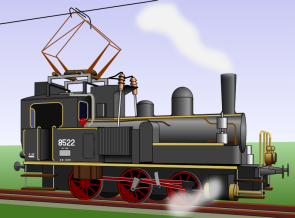 W
WA steam locomotive is a type of railway locomotive that produces its pulling power through a steam engine. These locomotives are fuelled by burning combustible material—usually coal, wood, or oil—to produce steam in a boiler. The steam moves reciprocating pistons which are mechanically connected to the locomotive's main wheels (drivers). Both fuel and water supplies are carried with the locomotive, either on the locomotive itself or in wagons (tenders) pulled behind.
 W
WA Bahnbetriebswerk is a German railway depot where the maintenance of locomotives and other rolling stock is carried out. It is roughly equivalent to a locomotive shed, running shed or motive power depot. These were of great importance during the steam locomotive era to ensure the smooth running of locomotive-hauled services. Bahnbetriebswerke had a large number of facilities in order to be able to carry out their various maintenance tasks. As a result, they needed a lot of staff and were often the largest employers in the area.
 W
WAn electric-steam locomotive is a steam locomotive that uses electricity to heat the water in the boiler to create steam instead of burning fuel in a firebox. This is a highly unusual type of locomotive that only makes economic sense under specific conditions. Normally, it would be much more efficient to build and use an electric locomotive. However, lack of time and resources, lack of coal or similar fuel, and the presence of relatively cheap and available electricity may make conversion of an existing steam locomotive into an electric-steam locomotive a viable proposition.
 W
WA fireman, stoker or watertender is a person whose occupation it is to tend the fire for the running of a boiler, heating a building, or powering a steam engine. Much of the job is hard physical labor, such as shoveling fuel, typically coal, into the boiler's firebox. On steam locomotives the title fireman is usually used, while on steamships and stationary steam engines, such as those driving saw mills, the title is usually stoker. The German word Heizer is equivalent and in Dutch the word stoker is mostly used too. The United States Navy referred to them as watertenders.
 W
W"Iron horse" is an iconic literary term for a steam locomotive, originating in the early 1800s when horses still powered most machinery, excepting windmills and stationary steam engines. The term was common and popular in both British and North American literary articles.
 W
WLocomotive Duplex was an experimental 4-cylinder steam locomotive designed by John Haswell of the Austrian State Railway Works at Vienna and built in 1861. It was exhibited at the 1862 International Exhibition and was then used on the line from Prague to Podmokly where it worked till 1900. Prague was the capital of Bohemia, which became part of the Austro-Hungarian Empire in 1867.
 W
WMcCloud Railway No. 18 is a 2-8-2 "Mikado" type steam locomotive built by Baldwin Locomotive Works. The locomotive was purchased new by the McCloud River Railway Company in 1914 as a standalone purchase. No. 18 was bought by the Yreka Western Railroad in 1956 and bought back by the McCloud in 1998. It was restored to operation in McCloud during 1998 and operated there until it was sold in 2005 to Virginia and Truckee Railroad. The unit operated on the V&T until it was slated for FRA inspection in 2015. It is currently under restoration at the Virginia and Truckee.
 W
WThis article is a glossary of the main components found on a typical steam locomotive.
 W
WA tram engine is a steam locomotive specially built, or modified, to run on a street, or roadside, tramway track.
 W
WThe Winton Train was a private passenger train that travelled from the Czech Republic to Great Britain in September 2009 in tribute to the wartime efforts of Sir Nicholas Winton, described as the 'British Schindler' for his part in saving refugee children from Czechoslovakia.